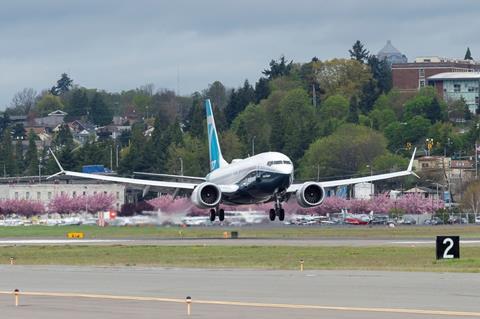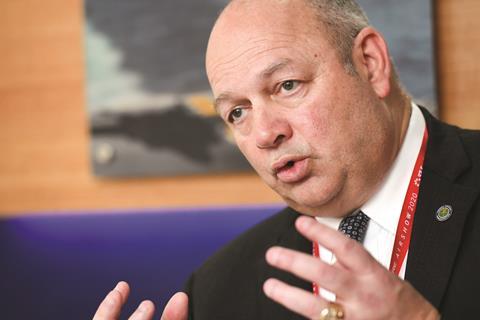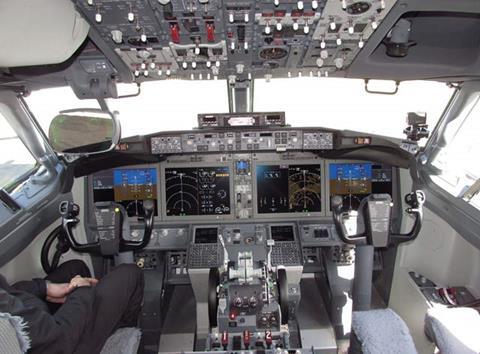Federal Aviation Administration chief Steve Dickson piloted a Boeing 737 Max on 30 September, declaring afterwards that the experience made him “comfortable” with the Max’s systems, but insisting his agency will certificate the jet only when convinced it is safe.
“I did two landings and also some air-work manoeuvres over about a 2h period,” administrator Dickson says after the flight, which occurred in the Seattle area. “I felt that the training prepared me to be very comfortable.”
Dickson flew 10 “flight scenarios” that involved experience with the jet’s Maneuvering Characteristics Augmentation System (MCAS) – the flight control system that contributed to two Max crashes.
Dickson also experienced “all the changes made to the flight-control computers and autopilot systems”, he says.
“I like what I saw on the flight this morning, but we are not to the point yet where we have completed the process,” he adds.

Dickson had no difficulty maintaining safe flight, even during scenarios in which the aircraft “was significantly out of trim”, he adds.
Still, Dickson says that prior to certificating the Max he intends to examine some outstanding concerns, including those related to “human factors” – meaning pilot responses to cockpit issues.

Investigations attributed the two Max crashes largely to how pilots responded to failures of the jet’s angle-of-attack (AOA) sensors, related cockpit warnings and activation of MCAS, which trims the Max nose down.
“We are grateful to the FAA for the rigorous process that will lead to the safe return to service of the 737 Max,” Boeing says. “We stand ready to provide the support required to complete the remaining milestones laid out by the FAA and international regulators.”
Boeing has said it expects regulators will certificate the Max in time for deliveries to resume in the fourth quarter.
Dickson, a former airline pilot with time on 737s and other Boeing and Airbus models, had long pledged to fly the Max prior to certification.
His flight was separate from the FAA’s still-ongoing official certification process.
“The flight today replicated [aspects] of the new design of the aircraft,” Dickson says. “I got a chance to see how the new system performed, and essentially it’s a much more benign system than the original design.”
“I felt very comfortable and very prepared based on the training… that I completed,” Dickson adds.
Prior to the flight, Dickson completed training recently recommended by the FAA’s Joint Operations Evaluation Board (JOEB).
He finished “virtual distance learnings” and other ground training, to “understand the systems and the new non-normal checklists that are being proposed”, Dickson says.
This week he also completed simulator training, “to gain experience with all of… those procedures, and [to] see how they work on the flight deck”.
Regulators grounded the 737 Max in March 2019 following the crash of a Lion Air jet in 2018 and that of an Ethiopian Airlines aircraft in 2019 – accidents that killed a combined 346 people.
The certification process has dragged on as investigators from several countries and various agencies examined the crashes. Investigators have attributed the crashes to issues related to FAA oversight, certification, the Max’s design, the actions of the pilots of the crashed jet, and maintenance procedures.
In addition to MCAS, the Max’s manual trim system has come under scrutiny due to reports that pilots can struggle to turn the Max’s manual trim wheel in certain flight conditions.
Dickson said he has no concerns about manual trim.
“If you maintain control of the aircraft, you are not going to have any problems in the normal flight envelope with the manual trim system,” he says.

Dickson addressed a question about whether Boeing’s design of the Max, and its alleged failure to fully disclose aspects of the aircraft, reflects systemic problems within Boeing.
“There were definitely issues of concern,” Dickson says. “I’m reserving the right to take additional action as we see fit.”
On 3 August, the FAA published a draft Max airworthiness directive (AD) that, when finalised, would clear the aircraft to return to service.
The proposed AD would require aircraft have updated flight-control software, and it would revise the jet’s flight-control manual. The manual would include new procedures intended to ensure pilots recognise and properly respond to AOA failures and erroneous horizontal stabiliser movements.
The AD also proposes that the Max receive new display system software – a change intended to help alert pilots when the jet’s two AOA sensors disagree. Additionally, the AD would require the Max’s horizontal trim wires be rerouted, which would make the jet comply with the FAA’s wire-separation requirements.
The FAA is still reviewing comments related to its proposed AD, and prior to certification the agency’s Flight Standardization Board will publish pilot training standards, with input from the JOEB.
Boeing made several changes to the Max amid the grounding. The updated MCAS relies on information from both of the aircraft’s AOAs, can only activate once, and cannot provide more input than pilots can counter using the control columns, according to Boeing.





























